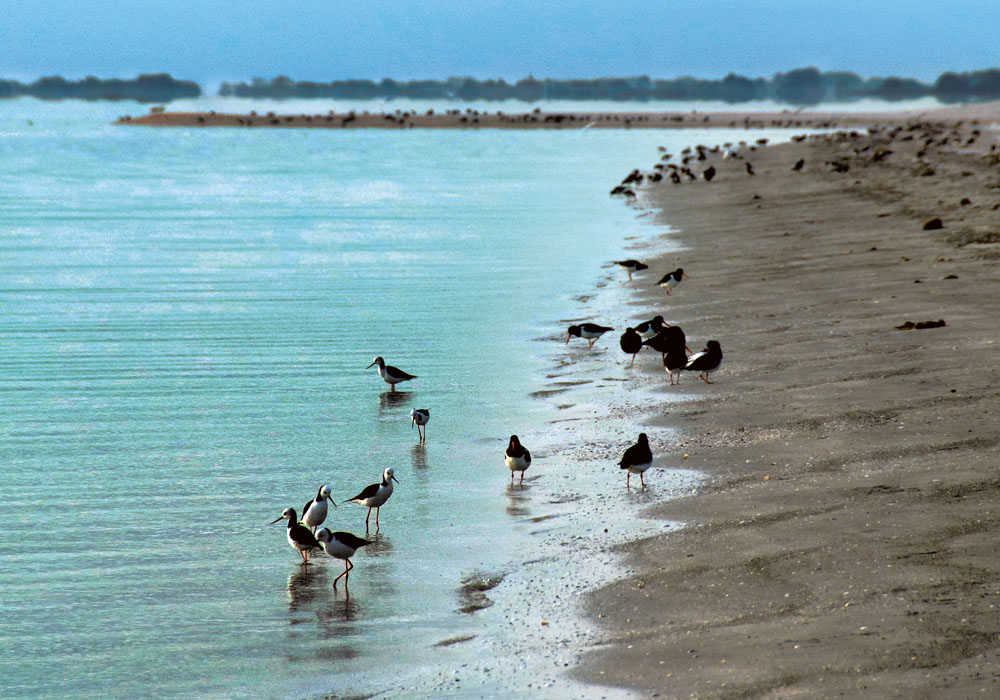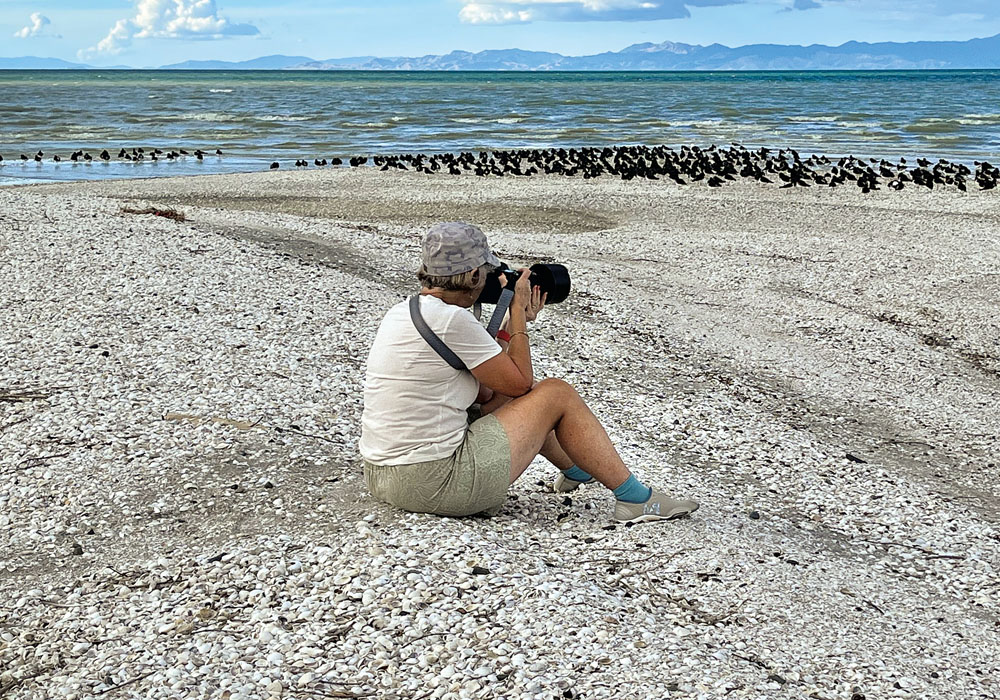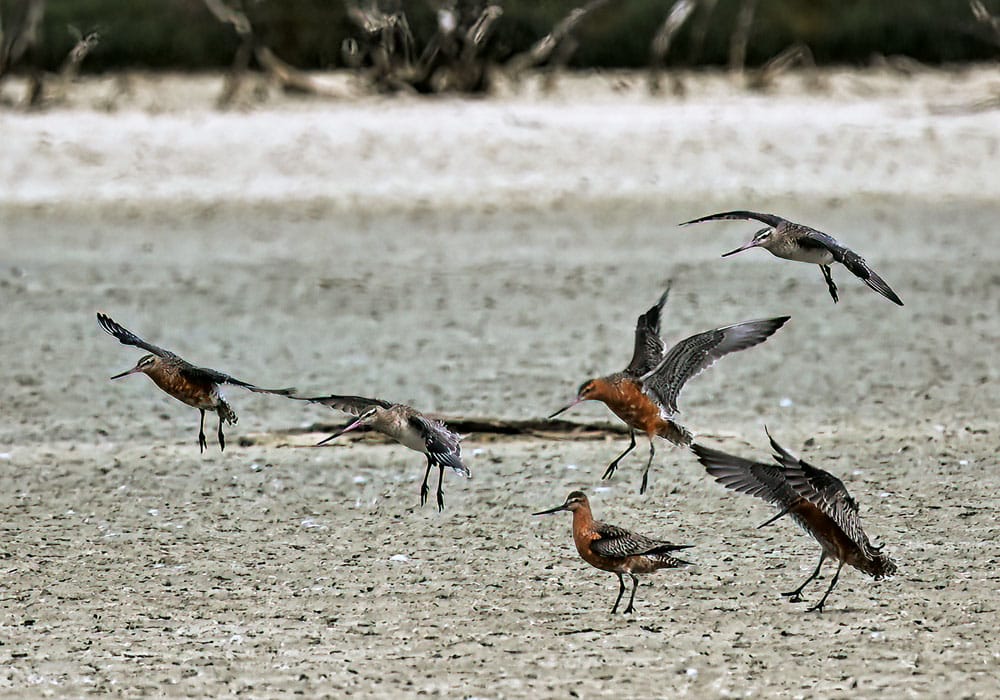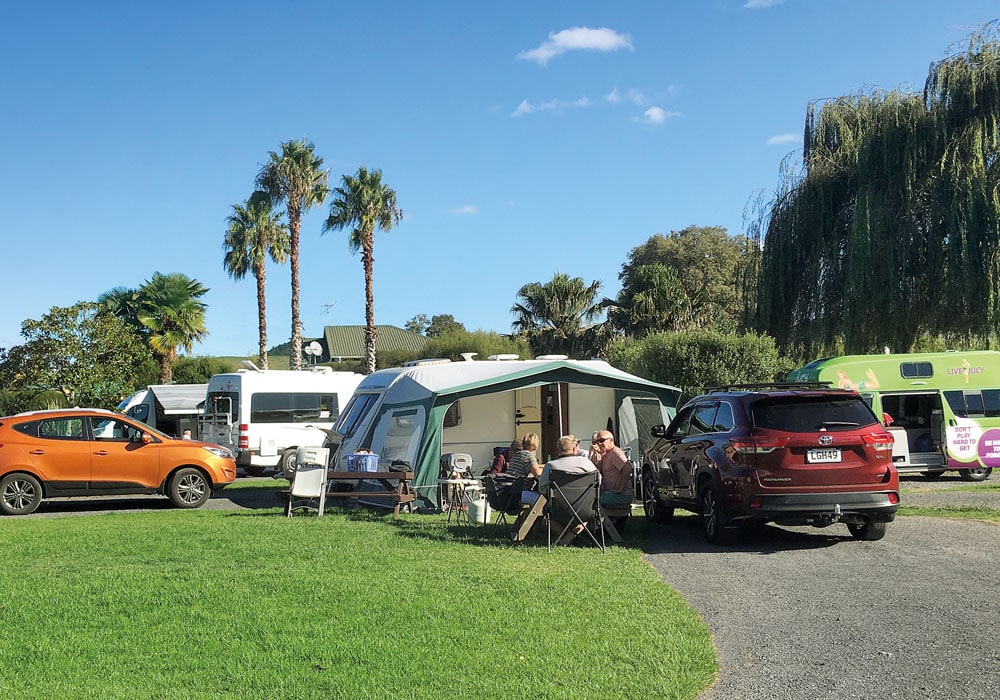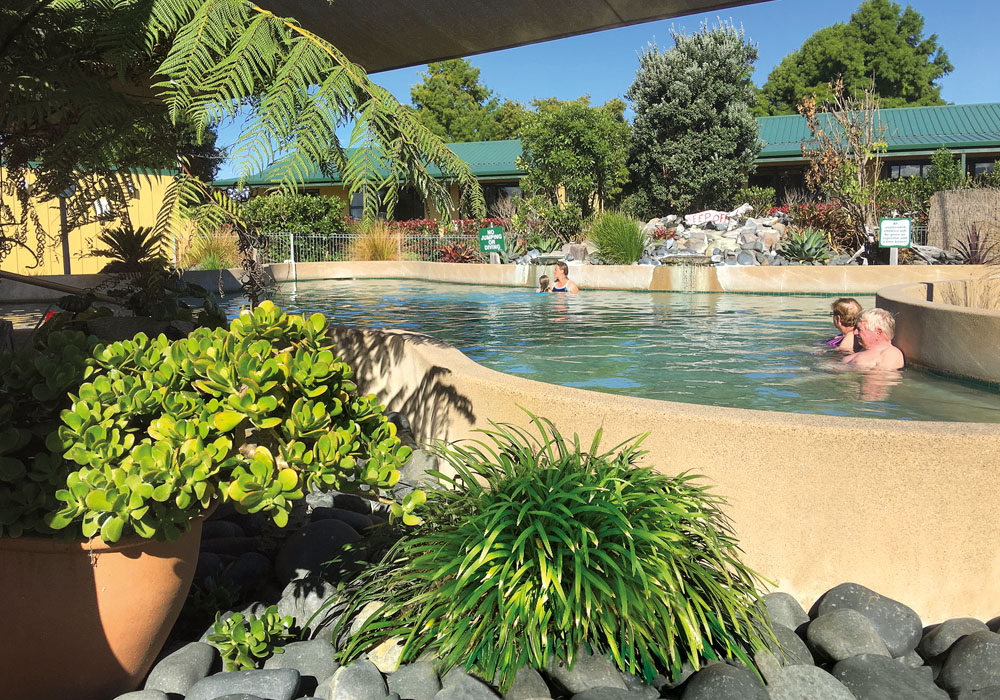Jill Malcolm revisits the shorebird coast of Miranda where, from September to October each year, godwits by the thousands come winging in at the end of their epic journey from Alaska.
In Australia, northward migrating RVers are called grey nomads; in America, they are dubbed snowbirds and from time to time, I’ve heard it suggested that travellers to the upper half of New Zealand in winter should be nicknamed godwits. Thank goodness the idea has never found fertile ground. It would be a travesty to compare the trickle of RVs to the ‘winterless north’ to the incredible birds that make one of the longest migratory journeys in the world.
Every March, thousands of godwits leave New Zealand for Alaska 12,000km away and, six months later, in September/October, they return. That feat is extraordinary enough but recently, it has been confirmed that on the return journey, they fly non-stop, without gliding, and at an average speed of 80km an hour. It takes them a mere six to eight days to jet in on schedule and land on one of the nutrient-rich estuaries around the country. How hungry, thirsty and exhausted they must be by then. It is partly this Herculean effort and partly because of our own migratory instincts, that this remarkable bird rates so highly in our affections.
Favourite feeding ground
Miranda on the Firth of Thames is one of the godwits’ favoured spots. Built up by the tides from gravel, sand and cockle shells, the low flat terraces of the Miranda coast comprise ridges of shell and a rich, intertidal larder of molluscs and worms. But it’s not just the godwits who come to dine here. Many other avian wing-ins feed on the mudflats, although, for amateur birdwatchers, it often takes patience to identify them. Keep looking and you might come to recognise dotterels, red knots, wry bills, white-fronted terns, and ruddy turnstones – and that’s just a start.
It is partly to witness this spectacle that droves of RVers (most displaying wings of their own, in the form of NZMCA membership) also migrate to this coast.
At an area known as Ray’s Rest, certified self-containment vehicles can freedom camp hard up against the beach; of all my happy places in New Zealand, this is top of the list. It is an uncommon privilege to sit on a deck chair outside our RV and as the high tide turns, watch a fascinating parade of wildlife unfolding two metres away.
I have watched pied stilts tiptoeing along on their spindly legs, a line of oyster catchers marching at the double along the water’s edge, and godwits plunging their bills so far into the sludge they looked as if they were face planting. I once thought I’d spotted a red-neck stint but that might have been fanciful. These sparrow-sized little birds also make a remarkable journey to and from Siberia, landing first in Australia before spreading their tiny wings and flying to New Zealand.
The scenes can be rich with drama. On one occasion I watched silver-back gulls shrieking murderously, quibbling over a fish head. A black-backed gull swooped in like a bully boy, claimed its prize and left. Further out a Caspian tern, in its handsome livery, cruised about 10 metres above the sea’s surface. It suddenly dive-bombed into the water and emerged with a sizeable fish clamped in its flashy red bill which it proceeded to swallow whole.
When the sea covers the flats, thousands of birds flock to roosting sites on the shell banks, swivelling in the breeze as they wait patiently for the tide to turn. Photographers, lured by this spectacle, crunch over the shells to find a position that will not put the birds to flight.
Something fishy
It is said that there are also rich pickings for fishermen in the Firth of Thames but this has never been evident while I have been at Ray’s Rest. I talked to one hopeful sitting on the beach under a large yellow umbrella watching the line he had cast into the water. “I’ve been here two hours,” he said. “Haven’t caught a thing – but it’s blissfully peaceful.”
Down the road from Ray’s Rest is the Pūkorokoro Miranda Shorebird Centre, an educational and information centre set up in 1990 to raise awareness of shorebirds and their habitats. Keith Woodley has been the manager there since 1993. Years ago he was an artist but became a born-again ornithologist when he started painting shore birds in his murals and realised how amazing they were.
“It’s hard for anyone to come and see or hear about the birds and leave unimpressed,” he says. “Hopefully they will also recognise the importance of looking after the health of the tidal flats. In my time here the number of godwits has halved, but the number of interested visitors has doubled. The birds’ feeding grounds as they fly north, in China and North Korea, are being taken over by development. However, there is a glimmer of hope that attitudes in those countries are beginning to change. We are certainly working on it.”
While I was with the expert, I asked him how godwits got their name. “There are several theories, I have my own,” he laughs. “I like to think they’re named after a minister who had a sense of humour!”

Getting into hot water
The Miranda coast is not just for the birds. The numerous pockets of hot mineral water that erupt through New Zealand’s outer crust can spring forth in the most unlikely places.
There’s nothing volcanic-looking about the flats on the western coast of the Firth of Thames, and yet at Miranda, a few kilometres north of the Waitakaruru River, an earthly gift of hot mineral water brimmed to the surface from an old fault line that gave rise to the popular Miranda hot pools complex. The Miranda pools are currently closed and nobody seems to know why (although there’s an unconfirmed rumour about an ownership change). But the Miranda Holiday Park next door has its own inviting, 38°C thermal pool surrounded by rock gardens.
The campsite is more like a resort. I discovered volleyball, tennis and petanque courts, a mini golf course and a giant-sized outdoor game of chess. Kids were leaping around like demented fleas on a large trampoline, families were circuiting the pathways in provided mini carts. And an area set to one side is a dog owners’ corner where RVs are allocated large, secure pens so their pooches can run free. Dogs are not allowed anywhere near the birds.
North of Ray’s Rest, accessed by road or cycle track, is the small settlement of Kaiaua with its tumble of buildings and boats. Disappointed fisherpeople and off-duty RV chefs patronise the well-known Kaiaua Fisheries takeaway shop operating in a small blue-coloured cottage. I’m told that the old-style Bay View pub and beer garden next door also has an excellent fish menu. I haven’t been there, but I have never spoken to anyone who has anything other than praise for the menu, the ambience and the good-natured staff.
More sustenance is to be found at the eye-catching Pink Store, which boasts that it serves the ‘best coffee in Kaiaua’ – an honest claim as I don’t know where else coffee is sold. The owner, Lynn Harvey, has had the store for many years. “Way back in the ‘70s before I owned it,” she told me, “it was painted pink. Through the years it had been painted many different colours but long-time residents always referred to it as the Pink Store. I repainted it pink because I thought it might as well show
its true colour.”
Several cyclists and bikers were mingling outside the store. They’d just finished this section of the 197km-long Hauraki Rail Trail and were stocking up. The trail, which is divided into five sections, officially starts here but many riders come from the other direction. From here, it follows the Shorebird Coast through the Karangahake Gorge and the old railway lines between the gold towns of Thames, Paeroa, Te Aroha, Waihi and Matamata.
Terry, a cyclist, had pulled into the store five minutes before and with alarming gusto was already demolishing a pie, an ice cream and a Coke. He told us he had cycled from Thames and was now fuelling up for the return ride.
“I’m what you call an ‘easy rider’,” he says. “I don’t go for speed. Just getting there and back is enough. It’s pretty flat all the way so it’s no big deal.” At close to 50km one way, it would be a big deal for me.

Bill and I gratefully returned to our motorhome, and after driving back to Ray’s Rest, we took our spot near the edge of the soupy water. It was a stunning evening. The sky lit up with fire as the sun took its leave, and when the landscape darkened, a large pineapple-coloured moon slid up from behind the Coromandel Peninsula to cast a wide yellow ribbon on the water’s surface. It seemed to lead directly to me.
Somewhere in the gloom, the birds were waiting out the night. The silence fell thickly around us. They would be back early the next morning but for the moment, the tranquil vista across the water to the black silhouette of the Coromandel belonged just to us.
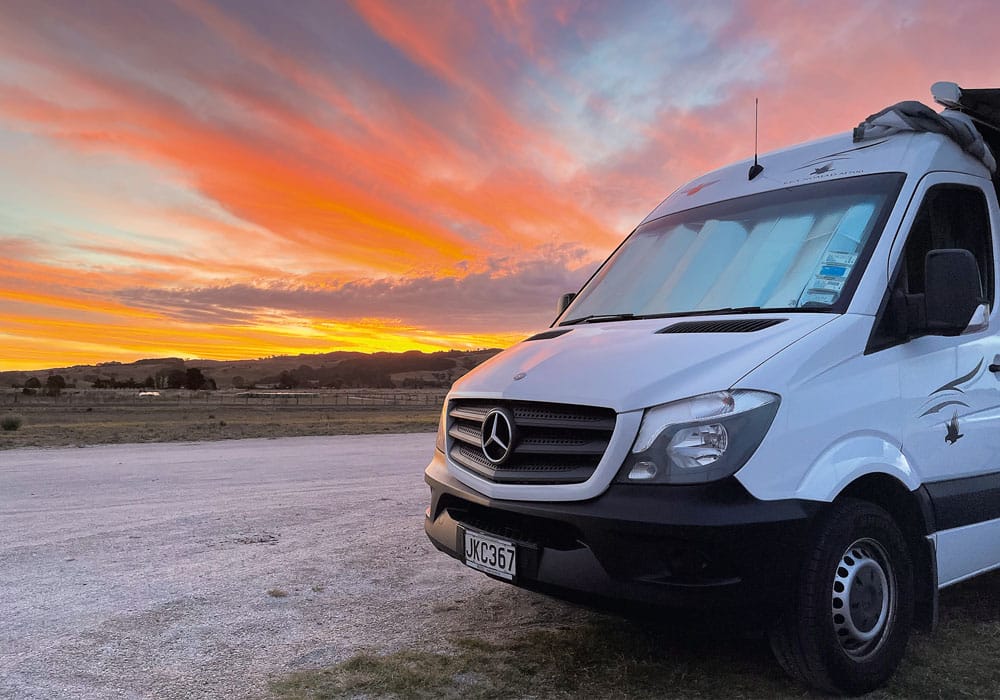
NOTE:
On 08 August 2022, the section of the Hauraki Rail Trail between Kopu and Waitakaruru was closed after heavy rain made it impassable. The closure is expected to apply until April 2023. The Shorebird section remains open.
FURTHER INFORMATION:
- Pūkorokoro Miranda Shorebird Centre is open daily 9am–5pm (except Christmas Day).
- The best time to see the birds is two hours on either side of high tide.
- Freedom camping at Ray’s Rest is for a maximum of two consecutive nights.
- Miranda Holiday Park has dump stations for black and grey water.
- There is a new NZMCA park in Kaiaua.
- Last visit, camping was also allowed in designated car parks on the shore north of Kaiaua (check first).

